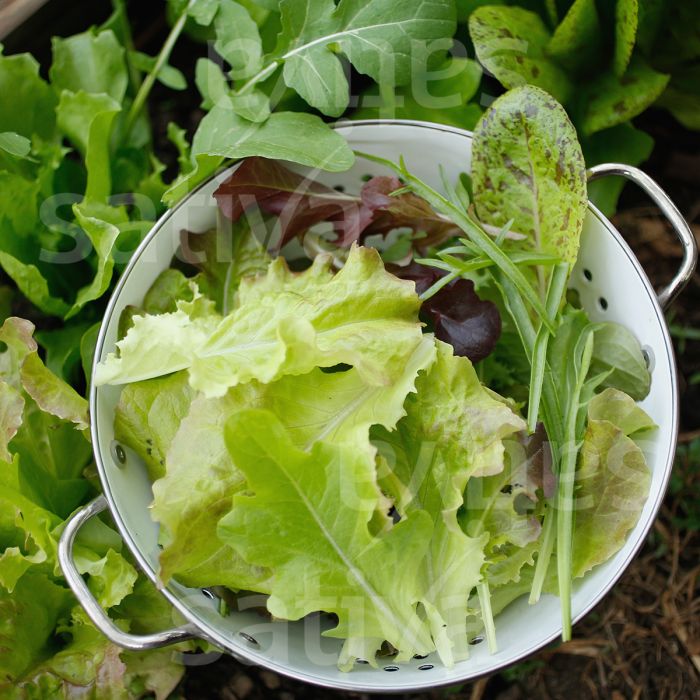MISTICANZA CUTTING LETTUCE - ps70
Have a question?

MISTICANZA CUTTING LETTUCE - ps70
Dettagli
Species: Lactuga sativa and Cichorium intybus
Family: Composite.
Brief history and botanical notes on the plant
Cutting salads include various cultivated species: arugula, mizuna, baby lettuce, lamb's lettuce, radicchio, etc. We will focus primarily on Lactuga sativa (e.g., cutting baby lettuce) and Cichorium intybus (e.g., "Verde a grumolo" or "Grumolo" or "Scirolo"), often mixed together in ready-to-use seed packets. Both are easy to grow, even for the hobbyist gardener. For botanical notes, refer to the technical data sheets already discussed for lettuce and radicchio.
Family and variety
When referring to cut salads, two species are mainly considered: Lactuga sativa and Cichorium intybus, both belonging to the Compositae family.
Seed retailers typically promote seed packets pre-prepared with a mixture of several varieties (e.g., 11 lettuces and 4 chicory varieties), which are generically called "misticanze." These salads are highly decorative (from green to red) and flavorful due to the richness of the blended varieties, but it's also possible to grow single varieties.
In cutting lettuce, the acephala variety includes varieties such as Trentina, Comune, Lollo, Verde ricciolina, Bionda ricciolina, Spinacio and Lattughino riccioli d'America.
Chicory or radicchio (Cichoriumintybus) is a perennial herbaceous plant. In cut chicory, the leaves are arranged like rose petals (a basal rosette); this arrangement is very evident in the “Grumolo verde scuro” or “scirolo” variety; in other varieties, the leaves are mostly narrow and elongated.
Pedoclimatic needs
These species stop growing at 6°C but can withstand temperatures as low as -2°C. It's important to remember that bolting is stimulated by temperatures above 25°C during the day and 14°C at night. They are all hardy and undemanding species and can be grown year-round, depending on seasonal temperatures and farm options (heated greenhouses, cold tunnels, open field, etc.).
Sowing and transplanting times
Field sowing can be done in two seasons: spring (around mid-February to late April) and autumn (September–October). They are sown in continuous rows (or in broadcast beds), maintaining a distance between rows of 15–25 cm depending on the mechanical weeding equipment used (hoe or tractor!).
Fertilizations
Cut lettuces require little nitrogen and phosphorus and benefit from a moderate amount of potassium. Therefore, these crops essentially don't require significant basal fertilization, and can be included in an initial or final crop rotation program, utilizing residual soil fertility.
Cultivation care and irrigation
When growing cut salads, transplanting is not done, but rather direct sowing in the field or under forced conditions (in a tunnel or greenhouse). Cultivation practices include preparing the seedbed with shallow, light tillage and controlling weeds in the rows using mechanical means.
Irrigation must be carried out to encourage seedling germination, considering that the soil must then maintain a certain level of humidity without becoming unnecessarily waterlogged, which could cause asphyxiation and rot.
Adversity
No specific adverse effects have been reported. It's good practice to maintain good crop rotation in the garden to prevent the development of fungal pathogens (Fusarium wilt), which generally affect specialized monoculture orchards where there is no crop rotation. Chicories are also extremely hardy.
Production and collection
Approximately 1 kg of cut leaves can be harvested from 1 m2. Harvesting begins approximately 50-60 days after sowing, by cutting the leaves (preferably with scissors) 3 cm from the ground when they have reached about 15 cm in height. New leaves then sprout, which lasts about 45 days, allowing for 2-4 harvests. In the garden, sowing can be done about 10-12 days apart to encourage continuous, staggered harvests.
Nutritional values
Nutritionally, lettuce is rich in vitamins (A and C), minerals (calcium, iron, magnesium, potassium), and soluble fiber, which is particularly effective in preventing arteriosclerosis. Since ancient times, all types of lettuce have been recognized for their calming, refreshing, analgesic, antioxidant, and appetite-stimulating properties. It's a good idea to start every meal with a plate of fresh lettuce.
Although the various varieties of chicory are often valued solely for their culinary value, we must not forget that they can also play an interesting role in nutritional and therapeutic supplementation. They contain a good amount of minerals, particularly calcium and iron, which significantly contribute to healthy body function. Their high fiber content stimulates daily bowel movements and facilitates water exchange by activating diuresis. Furthermore, their consumption increases the liver's production of bile, stimulating the liver's cleansing function and contributing to the reduction of blood cholesterol.
Biodynamics
Sowing, cultivation, and harvesting on leafy days. If the cultivated soil tends to be asphyxiated and compact, in addition to promoting aeration with appropriate tillage, it may be helpful to use horsetail macerate to prevent the entry of fungal pathogens in the more sensitive lettuces.



